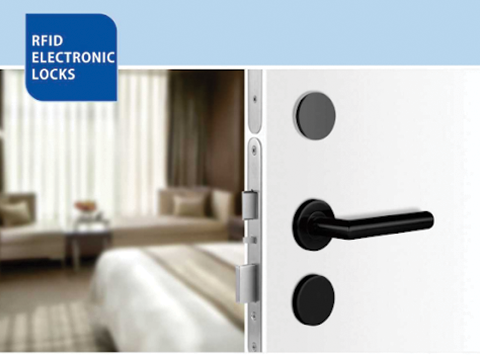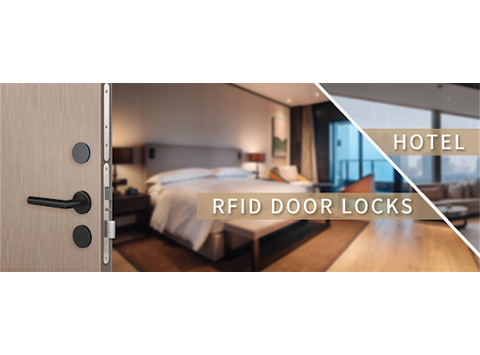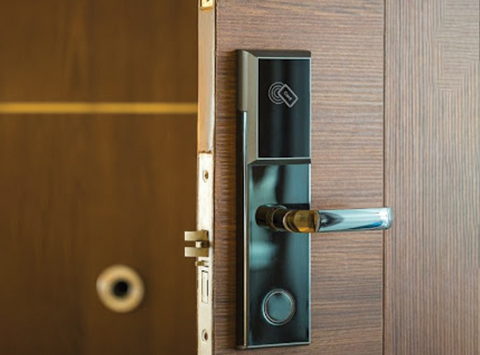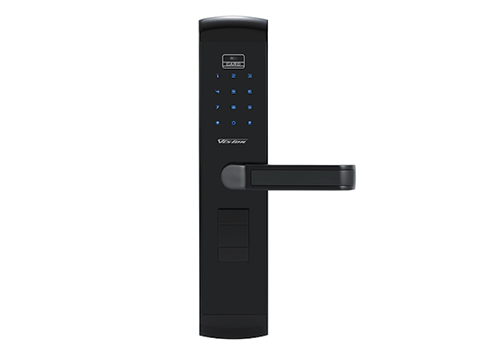
Electronic key card systems are a practical solution for securely and conveniently allowing their employees and house owners to enter and exit their offices and apartment buildings. There are several keyless entry control systems to choose from.
This comprehensive guide to security card reader systems discusses the various key card and key fob door entry systems, their benefits and drawbacks, the factors influencing the cost of key card door locks, and how to select the best door access security solution for their company.
They will find information on this page that will guide them through every facet of key card entry systems as well as key card formats. Be-Tech, a company that develops and sells cutting-edge door access control systems and electronic locks that are hosted in the cloud, has presented a review of the current status of access card technology.
Use this guide to learn about the various access card types, as well as their advantages and disadvantages, so that they may examine the requirements for their key card system.
What Are Key Card and Key Fob Systems?
They’ve almost certainly seen or used a plastic card, ID badge, or other electronic key cards that they swipe in front of a scanner to open a door or gain access to a location. Businesses all over the world use key card access control systems because they have been around for a while.
Key card and key fob door entry systems are widely used in parking garages, office buildings with multiple tenants, HOA communities with shared amenity zones, and large commercial offices with restricted access to specific areas.
Over time, keys have taken on a variety of technologically advanced shapes. As a result, key card access control systems as a whole have evolved.
Some of them, for example, may use a fob to enter their parking garage. Others may be able to gain access to their business building by using a key card bearing their image. They will almost certainly use a RFID card key to gain access to their hotel room.
How Do Key Fob and Key Card Systems Work?

Users can have peace of mind with a door access card reader system that controls who and when can enter a building. The three basic components of card reader access control systems are door card readers, electronic key card door locks, and door security cards. The door can be unlocked using proximity activation or by swiping a card with electric and magnetic card door lock systems.
The key card presented at the door card reader is recognized and authorized by the access control card system, causing the magnetic or RFID card door lock to unlock. The user can then unlock the door using the magnetic & RF card door lock system by using the push-bar, lever, or lockset. Magnetic card door lock systems immediately return the door to a locked state after the user closes it, ensuring that the door is always securely locked.
Electronic key card door lock systems can be activated by proximity, tapping the door card reader, or swiping a card through the reader, depending on the type of card reader entry system installed in the building. Some door access card reader systems support mobile unlocking via smartphone applications.
Using a card reader for door entry or key card gate access control helps to prevent unauthorized individuals from entering while allowing authorized users to enter. Unique permissions can also be assigned to door security cards.
Smart lock company BE-Tech and other card reader access management systems can be configured to grant user- or group-specific access privileges. A card access door lock system also records incidents of entry, which assists businesses in maintaining security.
Types of Door Entry Key Cards and Fob

Key cards and fobs are now available in a variety of styles. Even though they all serve the same purpose, understanding the differences between the most popular key card door access alternatives is critical when deciding on the best system for the site.
The number of doors to secure, the number of people using the key card door access system, and the desired level of security will all influence the best access control system. The three most common key cards and fobs are listed below.
RFID Key Card Door Lock and Fob
This method of access uses Radio Frequency Identification (RFID) to transmit card data to a reader, making it one of the most commonly used types of security key card door lock for home. RFID-enabled key cards and key fob systems can operate on a variety of frequency bands, depending on the purchasers’ needs and security access preferences. In order for data to be transmitted from proximity cards and RFID key fobs, the card must normally be relatively close to the reader.
Because they can be programmed to impose time and location restrictions on specific components, key fobs are an excellent choice for keyless access systems in larger building complexes. As a result, key fob systems for business tenants are commonly used in office buildings. Certain key fob door entry systems include PIN pads as an option for two-factor authentication.
Smart cards are a low-frequency RFID key card alternative that transmits data via Near-Field Communication (NFC). These cards, which are commonly found in contactless payment systems and credit cards, frequently have more storage space than standard RFID cards and include encryption for increased security.
Electromagnetic Key Card
An electromagnetic key card system for office, also known as an EM key card, is a key card that uses electromagnetism to unlock doors. EM key cards are commonly used in hotels and office buildings.
How do EM keycards work? When an EM key card is inserted into an electronic reader, the magnetically encoded stripe is read. The reader then instructs the door’s locking mechanism to unlock.
Because EM key cards cannot be duplicated, they are more secure than standard mechanical keys. Access to specific areas or times of day can also be granted or denied using EM key cards.
Proximity Cards
Proximity cards, also known as proximity tokens, are used in physical access control equipment. They are used to grant access to restricted areas. A radio frequency identification chip and/or a magnetic stripe are included in the card.
When a card is scanned, a signal has emitted that powers the chip or activates the magnetic stripe. The card then communicates with the reader. This information is used to either grant or denies access. Physical and logical access control can be accomplished with proximity cards.
The regulation of who can physically enter a location, such as a building or a room, is referred to as physical access control. The process of determining who has access to computer networks and systems is known as logical access control.
Smart Cards
Smart cards are the identification verification technology of the future. These cards can be used for a variety of purposes, including identity verification, transaction authorization, and record access. They contain a chip that contains information about the cardholder.
These are more secure than traditional methods of identification, and they are gaining popularity as more businesses and organizations use them for various purposes. In the near future, it will replace keys and ID badges as the primary form of identification and access control.
NFC Key Cards and Emulators
NFC key cards are tangible objects that can be used to enter doors, unlock gadgets, and obtain access to data. These capabilities make NFC key cards very useful. Emulators are a type of computer program that can recreate the actions of a piece of hardware or another piece of computer software.
They make it possible for one to test out new gear and software without requiring the user to actually purchase the components themselves.
To get access to data, devices, and buildings, a rising number of users are adopting NFC key cards and emulators. This trend is expected to continue. They offer a solution that is both more convenient and safe than conventional methods such as using keys and passwords.
Hybrid Key Cards
An access control system known as a hybrid key card utilizes both a transponder chip and a magnetic stripe to allow authorized individuals to enter a building or secure area. While the magnetic stripe is where the information about the cardholder is stored, the transponder chip is what really opens the apartment door lock by sending a signal to the reader.
The use of hybrid key cards is on the rise because, in comparison to traditional magnetic stripe cards, they offer a higher level of safety. The data stored on the magnetic stripe can be encrypted, and the presence of the transponder chip makes it more difficult to produce a fake card.
The use of hybrid key cards is the optimal solution for establishments like banks and government buildings that are required to maintain the greatest level of security. They are increasingly being included into residential structures in order to add an additional level of security.
Wiegand Key Cardsbarcode Cards
Wiegand key cards were among the first types of electronic key cards. The Wiegand key card honors John R. Wiegand, the inventor of a technique for encoding binary data into specialized wires using magnetic polarization.
Magnetic fields were emitted by Wiegand readers. When a user swipes a Wiegand card through a reader, the magnetic field affects the card’s wires. The reader notices these wire modifications in order to verify the user’s credentials.
Despite the fact that Wiegand magnetic cards first gained prominence in the 1970s, Wiegand technology continues to be the foundation of a significant portion of the access control ecosystem today.
Pros and Cons of Key Card or Key Fob Access Control System

To provide employees, rentals, and families with simple access control, the majority of businesses use electronic key card systems. If someone loses a card, resigns, or is terminated, it is easier to deactivate a single card than to rekey all of the locks. Consider the pros and cons of using key cards as an access control option during a safety assessment.
| Pros | Cons |
| Intuitive for tenants Record-KeepingMultiple locations Restrict access Grant Access Improve productivity No Unauthorized Written Records Implement a lockdown procedure Logging Access Activity Easier to Change Difficult to duplicate | No guest access |
Alternatives to Key Card and Fob Entry Systems
Key cards are not required if one chooses to go keyless. In fact, several of these access control alternatives may be a better fit for a company’s and residential needs. Let’s take a look at the four most common keyless entry systems.
Micro Tags
Micro tags are small stickers that use HID proximity technology to communicate. By applying a micro tag sticker to a photo ID or security badge, one can easily convert it into a proximity card. It is simple to connect and present to a scanner to unlock a door or other facility.
Mobile Credentials
Individuals can open doors with their mobile credentials rather than a key card. It functions similarly to a key fob or micro tag and is the most modern solution for door access control systems.
The unique user ID is stored on the mobile device rather than on a physical card (usually as a mobile app). Then, using an electronic lock and a reader, it can be used as an electronic key to unlock a door. The smartphone can communicate with the reader via Bluetooth or a mobile app that includes pre-programmed unlock features for devices on the same wifi network.
Because it limits virus spread, this touchless access control technology has emerged as a critical access control solution for the 2020 coronavirus pandemic.
Biometric Access Door Entry System
A biometric key card door access system, which is common in government, banking, and medical facilities, improves security. For user authentication, biometric access control systems use a person’s fingerprint, retina scan, or facial recognition software.
Biometrics are used as a form of two-factor authentication in many commercial key card door lock systems, requiring the user to undergo a biometric scan before scanning a credential.
Keypads
Instead of a key card or fob, this type of keyless locking system employs a PIN code or passcode as the credential. The user must enter their PIN on a keypad to open the door. Although these electronic door lock scanners are convenient, they require a passcode and must be reset on a regular basis to maintain security.
Keypad readers are sometimes used in conjunction with a commercial key card door lock for high-security or restricted access locations, requiring the user to first scan their key card or fob and then enter a passcode to gain entry.
QR Codes
According to a recent survey, key cards and fobs are being phased out as the preferred access mechanism. QR codes have several advantages over traditional key card systems, including being more convenient and less expensive, according to the study.
One of the primary benefits of QR code entry systems is that they can be used with any smartphone. This eliminates the need to carry a second key card or fob, which can easily be misplaced or stolen. Furthermore, QR code entry methods are far more difficult to duplicate than traditional key cards.
QR code input systems provide increased security as an added benefit. Key cards and fobs are easy to duplicate or steal, but it is much more difficult to duplicate a QR code.
Video Intercom for Front Door Access
Commercial key card readers with video capabilities have become the industry standard for improving door security. Organizations can view live footage of every access event from the location where it occurs thanks to video key card readers.
If one wants to maximize the return on investment, look for video and door intercom readers with high-definition cameras, support for all access methods, such as encrypted key cards, and all access techniques including low- and high-frequency credentials are supported.
Conclusion
Key cards and fobs have numerous advantages over traditional locks and metal keys. All key fob systems, including Wiegand, swipe, RFID hotel door lock system, and proximity, rely on users carrying hardware.
The key card and key fob lock are still the popular lock types in mobile access control systems. Residents can use their cards or mobile phones to unlock doors, greet guests, and accept deliveries, ensuring a safe and convenient access experience. Contact BE-TECH to get an RFID card lock for your hotel or home, Be-tech is a professional key card lock manufacturer, and China’s largest smart lock testing facility is located in our factory which has been ISO-accredited and spans over 30,000 square meters. Our quality and price of RF card lock and system won’t let you down. Everything BE-TECH do is geared toward satisfying its customers with superior goods and services.
Blogs you may be interested in:
